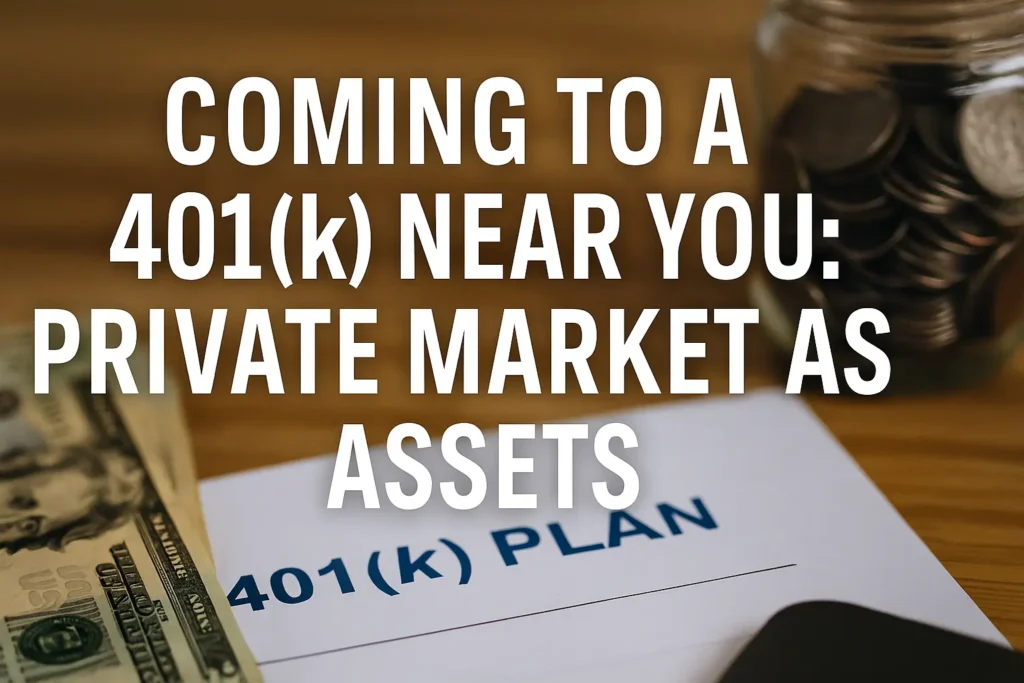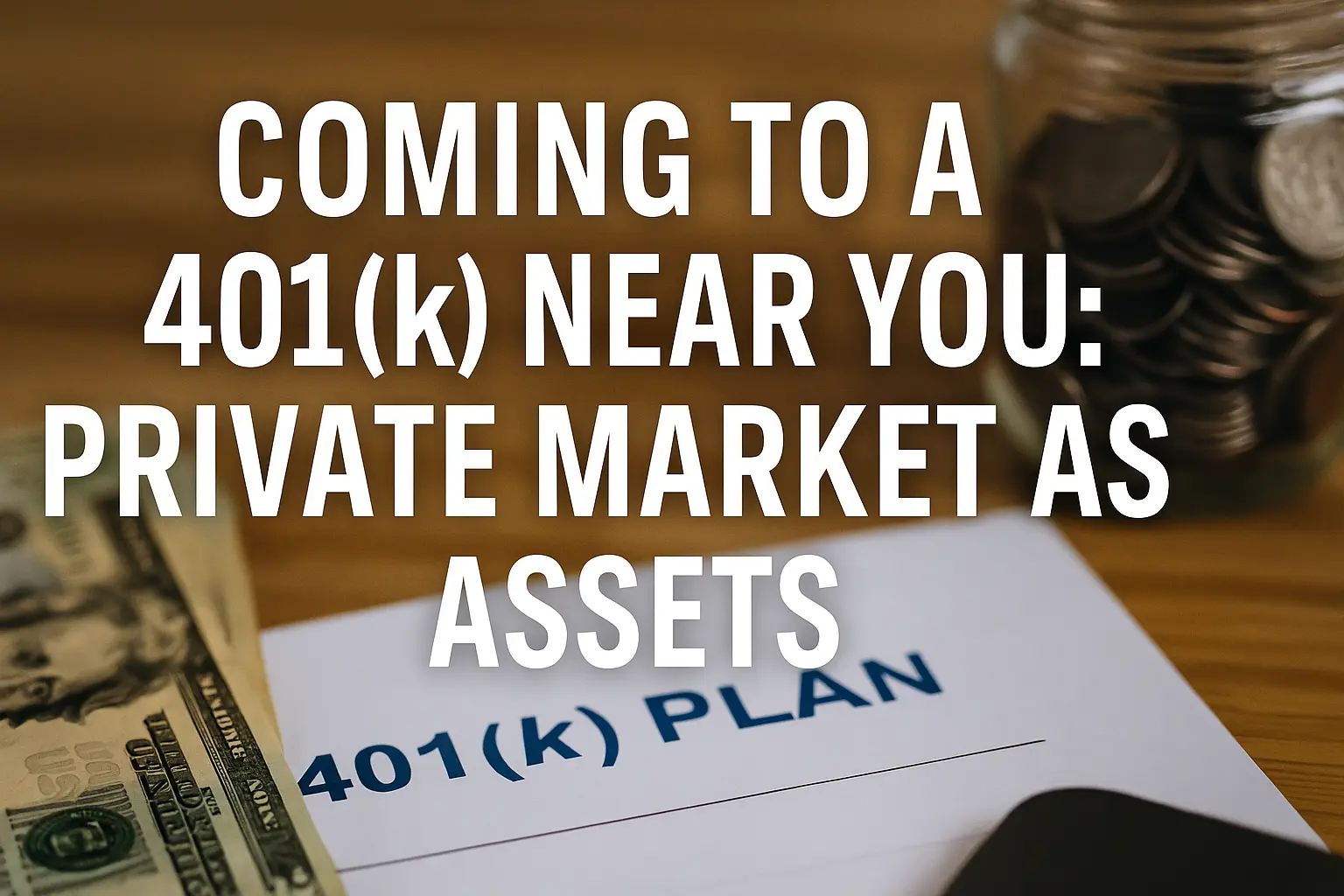Private market assets are coming to your 401(k) in 2025 — including private equity, credit, and real estate. Discover what this means for your retirement, the benefits, risks, and how to take advantage of this new opportunity.
Your 401(k) is about to get a serious upgrade — and it’s not just more mutual funds or target-date options.
For the first time ever, private equity, private credit, real estate funds, and other “private market” assets are coming to mainstream retirement plans.
If that sounds complicated or intimidating, don’t worry — we’re going to break down exactly what it means, why it’s happening now, and whether it’s a good thing for your long-term financial future.
Let’s start at the top.
🔍 What Are Private Market Assets, Anyway?
Traditionally, your 401(k) holds public market investments — like:
- Stocks (via mutual funds or ETFs)
- Bonds
- Target-date funds
- Index funds like the S&P 500
But private market assets operate outside of the stock exchange. They include:
| Type | Description |
|---|---|
| Private Equity | Investments in private companies before they go public — think early Uber or SpaceX |
| Private Credit | Loans made by private institutions, not banks or bond markets |
| Venture Capital | High-risk, high-reward startup investing |
| Private Real Estate | Direct real estate deals, not REITs traded on stock exchanges |
| Infrastructure Funds | Investments in roads, utilities, bridges — long-term assets with steady cash flow |
These types of investments were previously reserved for:
- Ultra-wealthy individuals
- Hedge funds
- Pension funds
- Institutional investors
But that’s changing — fast.
🧠 Why Are Private Markets Coming to 401(k)s Now?
Two big reasons:
1. Demand for Diversification
2022–2023 taught many investors a painful lesson:
Stocks and bonds can fall at the same time.
To reduce risk and improve returns, retirement planners are turning to non-traditional assets — and private markets fit the bill. They’re often less correlated with public markets and can provide:
- Higher long-term returns
- More income potential
- Better inflation protection
2. Regulatory Green Light
In 2020, the U.S. Department of Labor issued new guidance allowing private market investments in 401(k)s — under specific rules. That guidance has since evolved, and now more retirement plan providers are integrating these assets into their offerings.
💼 Who’s Offering Private Market Access in 401(k)s?
As of mid-2025, here are some major players rolling out access:
- Fidelity: Launched a diversified “private credit fund” for select 401(k)s
- BlackRock: Partnering with iCapital to offer institutional private equity exposure
- Vanguard: Testing private real estate access in target-date retirement funds
- Empower Retirement: Announced partnerships with private equity platforms
- T. Rowe Price: Adding private infrastructure funds to retirement models
These aren’t DIY stock picks — they’re carefully designed, diversified funds meant to give you exposure without too much complexity.

📊 What’s the Potential Upside?
Let’s be honest: this isn’t about chasing fast money. It’s about long-term portfolio strength.
✅ 1. Higher Returns
Historically, private equity and private credit have outperformed public stocks — often by 2% to 4% annually, according to PitchBook and Preqin.
That may not sound like much, but over 30 years, the difference between a 6% and 8% return could mean hundreds of thousands of extra dollars in retirement.
✅ 2. Reduced Volatility
Because private assets aren’t priced minute-to-minute like stocks, they tend to:
- Smooth out portfolio performance
- Avoid emotional investing triggers (panic selling)
- Keep your retirement plan steadier during market downturns
✅ 3. Access to New Opportunities
You’re no longer limited to the same few mutual funds everyone else is buying.
You can invest like an endowment — with access to growth-stage companies, debt deals, and long-term infrastructure projects.
⚠️ But What Are the Risks?
Let’s not sugarcoat it — private markets are not risk-free. In fact, they come with some unique challenges:
❗ 1. Liquidity Issues
You can’t just sell your private fund shares overnight. Most of these funds:
- Lock up your money for 3–10 years
- Have limited windows for redemptions
- Are designed for long-term commitment
That’s OK for retirement investing, but not great if you need fast access to cash.
❗ 2. Complexity
Understanding how a private equity fund works is harder than understanding an S&P 500 ETF.
You’ll need to trust:
- Your plan’s fund managers
- The transparency of the provider
- The structure of fees and risk
❗ 3. Higher Fees
Private market funds typically charge higher fees than passive index funds.
You might see:
- Performance fees (20% of profits)
- Management fees (1–2% annually)
However, many 401(k) versions of these funds are institutional class, with fees negotiated down for large groups.
🧮 Real Example: How It Could Work in Your 401(k)
Let’s say your 401(k) provider adds a Target Date 2060 Fund that now includes:
| Asset Class | Allocation |
|---|---|
| Public Stocks | 55% |
| Bonds | 20% |
| Private Equity | 10% |
| Private Credit | 10% |
| Real Assets (Real Estate, Infra) | 5% |
This diversified setup could:
- Reduce downside during recessions
- Capture long-term gains from non-public markets
- Boost retirement readiness with better compounding
Of course, you’d still have the option to go 100% public index funds — but adding 10–20% private exposure could give your portfolio a real edge.
👨👩👧👦 Is This Good for the Average American?
It depends. Here’s how to think about it:
| Factor | If You’re… | Impact |
|---|---|---|
| Age 25–40 | Long time until retirement | Private assets are a great fit |
| Age 50+ | Nearing retirement | Go slow, liquidity matters |
| Low risk tolerance | Prefer safety over growth | Stick to traditional funds |
| High net worth | Want stronger growth | Private markets offer advantages |
The key takeaway?
This isn’t a revolution. It’s an evolution.
You won’t be betting your retirement on startups — but you might own a tiny slice of a data center fund, a mid-market private credit deal, or a biotech venture.
🛠️ How to Access These Funds
If you’re interested, here’s what to do:
✅ 1. Check Your 401(k) Provider
Log in to your account and review:
- New fund options
- Target-date funds with alternative asset exposure
- Educational materials about private markets
✅ 2. Talk to HR or Your Plan Admin
Ask:
- Will new investment options be added this year?
- Are there lower-fee alternatives for private markets?
- Can you get access to a financial advisor or planner?
✅ 3. Start Small
You don’t need to overhaul your entire portfolio.
Try allocating:
- 5–10% to a private credit or equity fund
- 5% to a private infrastructure or real estate fund
Monitor performance annually and adjust accordingly.
🧭 Final Thoughts: A New Era for Retirement Investing
For decades, 401(k) investing was relatively simple. You bought an index fund, hoped for 7% a year, and waited.
Now, we’re entering a new frontier — where private markets, once reserved for billionaires, are becoming accessible to everyday Americans.
That’s powerful.
But it’s also a reminder that with more choice comes more responsibility.
So educate yourself. Ask questions. Read the fund materials.
Because this new opportunity could be the difference between retiring comfortably — or retiring early.
📌 TL;DR – Private Markets in Your 401(k)
- What’s Changing? Private equity, credit, and real assets are coming to 401(k) plans
- Why Now? Investor demand + regulatory approval + product innovation
- What’s the Benefit? Higher returns, lower volatility, long-term growth
- What’s the Risk? Less liquidity, higher fees, more complexity
- What Should You Do? Start small, diversify, and stay informed

Also Check This Post
Trump Announces 30% Tariffs on EU and Mexico Starting Aug. 1 — What It Means for Americans
